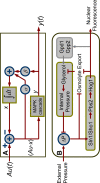The frequency dependence of osmo-adaptation in Saccharomyces cerevisiae
- PMID: 18218902
- PMCID: PMC2916730
- DOI: 10.1126/science.1151582
The frequency dependence of osmo-adaptation in Saccharomyces cerevisiae
Abstract
The propagation of information through signaling cascades spans a wide range of time scales, including the rapid ligand-receptor interaction and the much slower response of downstream gene expression. To determine which dynamic range dominates a response, we used periodic stimuli to measure the frequency dependence of signal transduction in the osmo-adaptation pathway of Saccharomyces cerevisiae. We applied system identification methods to infer a concise predictive model. We found that the dynamics of the osmo-adaptation response are dominated by a fast-acting negative feedback through the kinase Hog1 that does not require protein synthesis. After large osmotic shocks, an additional, much slower, negative feedback through gene expression allows cells to respond faster to future stimuli.
Figures




Comment in
-
Systems biology. Enlightening Rhythms.Science. 2008 Jan 25;319(5862):417-8. doi: 10.1126/science.1154208. Science. 2008. PMID: 18218882 No abstract available.
Similar articles
-
Systems biology. Enlightening Rhythms.Science. 2008 Jan 25;319(5862):417-8. doi: 10.1126/science.1154208. Science. 2008. PMID: 18218882 No abstract available.
-
A systems biology analysis of long and short-term memories of osmotic stress adaptation in fungi.BMC Res Notes. 2012 May 25;5:258. doi: 10.1186/1756-0500-5-258. BMC Res Notes. 2012. PMID: 22631601 Free PMC article.
-
Activation of the Hog1 MAPK by the Ssk2/Ssk22 MAP3Ks, in the absence of the osmosensors, is not sufficient to trigger osmostress adaptation in Saccharomyces cerevisiae.FEBS J. 2018 Mar;285(6):1079-1096. doi: 10.1111/febs.14385. Epub 2018 Jan 30. FEBS J. 2018. PMID: 29341399
-
Hog1: 20 years of discovery and impact.Sci Signal. 2014 Sep 16;7(343):re7. doi: 10.1126/scisignal.2005458. Sci Signal. 2014. PMID: 25227612 Review.
-
Yeast go the whole HOG for the hyperosmotic response.Trends Genet. 2002 Aug;18(8):405-12. doi: 10.1016/s0168-9525(02)02723-3. Trends Genet. 2002. PMID: 12142009 Review.
Cited by
-
Feedforward regulation ensures stability and rapid reversibility of a cellular state.Mol Cell. 2013 Jun 27;50(6):856-68. doi: 10.1016/j.molcel.2013.04.014. Epub 2013 May 16. Mol Cell. 2013. PMID: 23685071 Free PMC article.
-
Environmental conditions drive self-organization of reaction pathways in a prebiotic reaction network.Nat Chem. 2022 Jun;14(6):623-631. doi: 10.1038/s41557-022-00956-7. Epub 2022 Jun 6. Nat Chem. 2022. PMID: 35668214
-
Rhythmicity and waves in the cortex of single cells.Philos Trans R Soc Lond B Biol Sci. 2018 May 26;373(1747):20170116. doi: 10.1098/rstb.2017.0116. Philos Trans R Soc Lond B Biol Sci. 2018. PMID: 29632268 Free PMC article. Review.
-
Adaptive-control model for neutrophil orientation in the direction of chemical gradients.Biophys J. 2009 May 20;96(10):3897-916. doi: 10.1016/j.bpj.2008.12.3967. Biophys J. 2009. PMID: 19450463 Free PMC article.
-
Genome-scale transcriptional dynamics and environmental biosensing.Proc Natl Acad Sci U S A. 2020 Feb 11;117(6):3301-3306. doi: 10.1073/pnas.1913003117. Epub 2020 Jan 23. Proc Natl Acad Sci U S A. 2020. PMID: 31974311 Free PMC article.
References
-
- Tyson JJ, Chen K, Novak B. Nat Rev Mol Cell Biol. 2001;2:908–16. - PubMed
-
- Slepchenko BM, Schaff JC, Macara I, Loew LM. Trends Cell Biol. 2003;13:570–6. - PubMed
-
- Kitano H, Funahashi A, Matsuoka Y, Oda K. Nat Biotechnol. 2005;23:961–6. - PubMed
-
- Klipp E, Nordlander B, Kruger R, Gennemark P, Hohmann S. Nat Biotechnol. 2005;23:975–82. - PubMed
-
- Oppenheim AV, Willsky AS, Young IT. Signals and systems. Prentice-Hall; 1983.
Publication types
MeSH terms
Substances
Grants and funding
LinkOut - more resources
Full Text Sources
Molecular Biology Databases

